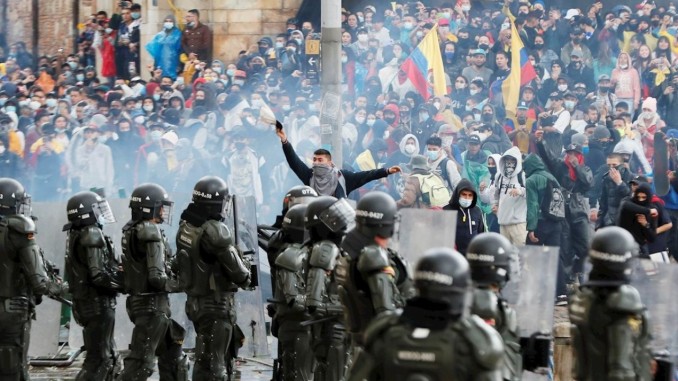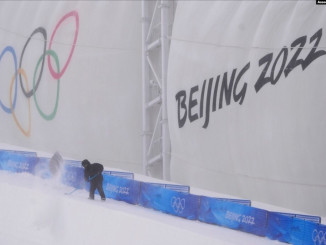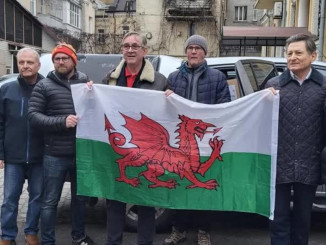
Translated from the French May 12, 2021 article in Convergences Revolutionnaires by the Etincelle fraction of the NPA
https://www.convergencesrevolutionnaires.org/Colombie-la-repression-ne-brise-pas-le-soulevement-social
Colombia is experiencing one of the most important waves of protests in its history after those of 1977 and 1981 when large insurrectional strikes were broken by fierce repression. Already in these years 1970-80, the protest had taken hold of the streets to fight against austerity measures claiming a “fiscal deficit” and the implementation of the brutal so-called “neo-liberal” policy born in the blood in Chile. in 1973.
The origins of the struggle
The Colombian social crisis, which was expressed in two stages in 2019 and at the end of April 2021, is part of the chain of popular revolts, begun two years ago in Puerto Rico, which crossed Ecuador, Peru, Chile and, most recently, Paraguay.
We can locate the starting point of the demonstrations underway on November 21, 2019, “21N”, where the “Paro Nacional” (national strike) had been convened by the CNP ( Comité Nacional de Paro , National strike committee) made up of trade unions, student organizations and social leaders (animators or spokespersons for peasant communities or indigenous peoples, leaders of human rights organizations, union leaders).
Responding to this call, hundreds of thousands of demonstrators marched in the street against the reform known as the “paquetazo”, the “big package” of measures because of their number, and the disproportion between the sacrifices required of the poor and the rich. This multitude of attacks against workers ranged from the possibility of paying 75% of the minimum wage to young people under 25 to the destruction of the public pension system, through the lowering of the retirement, as well as the freedom to hire by the hour. All this was being done under the pretext of budgetary savings, against the backdrop of a merger of state financial entities leading to massive layoffs.
Just like today, the demands of students and workers did not stop with the withdrawal of the announced reforms. They were part of long-term struggles against deplorable living conditions, with an unemployment rate officially at 19% – and an informal employment sector of 40%. But also against the very numerous assassinations of social activists (nearly a hundred per year over a period of a decade), against the catastrophic management of the peace agreements signed in 2016 with the FARC (Revolutionary Armed Forces of Colombia) and the pointlessness of the programs developed to transition out of the narco-economy, especially in agricultural areas, with the aerial diffusion of glyphosate in order to fight against the cultivation of coca plants. (The use of glyphosate destroys illegal crops, but poisons the population. This alleged fight against coca leaf cultivation obscures the fact that subsidies were provided for these farmers as part of the 2016 Havana accords ending the armed struggle.)
This mobilization of Nov. 21 2019 was stifled by the pandemic and confinement. However, during this period, the social situation was punctuated by large-scale protests against police violence after the assassination of the lawyer Javier Ordoñez, as part of a certificate control during confinement. He was beaten, suffocated, and tased until he died in a CAI (Comando de Atención Inmediata, a local neighborhood police station). President Iván Duque, a member of the Centro Démocratico, then went out in police uniform on television to express his support for all the police, angering the residents of the neighborhoods and students who set fire to more than forty CAIs and denounced the reality of these detention centers, known to all as places of torture, but also micro-platforms for the sale of drugs, true centers of drug-dealing management in the neighborhoods.
The weight of the informal sector (40%) had serious consequences during containment: the households that depend on it received no substantial aid – when it was not simply diverted by the mayors who had it assigned to people who were deceased. Everyone who ran out of food hung red flags on their windows as a sign of distress. We could walk around the working-class neighborhoods of all the cities and see this call for help in every street, which provoked rallies to challenge the mayors and denounce the critical situation. Colombians have therefore seen once again, as public money was transferred to large companies like Avianca – the main airline – how little the ruling class and its state cared about their lives.
The trigger: tax reform
It is in this context that the “tributaria” reform – or tax reform – was proposed to Parliament, claiming to raise more than 26,000 billion Colombian pesos (approximately 6 billion euros or over 7 billion U.S. dollars) by increasing the rate of the IVA ( the equivalent of our sales tax) on basic necessities which would go from 5% to 19%, but also by expanding the tax rate on wages. In fact, an employee must now file a tax return on 4.9 million Colombian pesos of monthly income (approximately 1,314 U.S. dollars). With the reform, the reporting threshold would start at 3.5 million pesos (around 949.00 U.S. dollars). This reform follows two other tax reforms (the Financing Law and the Growth Law) exempting certain sectors of industry and commerce from taxes and Value Added Tax (IVA), implemented under the government of Iván Duque. Thus, this increase in IVA will not affect, for example, Postobon, a major producer of soda and sugar, but it will weigh heavily on the “canasta familiar” (the food basket of households).
During the pandemic the Duque government did not deprive itself of paying money to large companies under the pretext of protecting jobs, while, at the same time, it approved reforms to “flexibilize” labor. The government foreign debt reached 54.8% of GDP. This reform proposal is therefore once again a way of forcing the full weight of the crisis onto the backs of the workers, and of meeting the demands of the IMF (International Monetary Fund) and the OECD (Organization for Economic Cooperation and Development), both of which put pressure on the government to keep paying the public deficit.
Faced with these measures, the three trade union centers and the CNP called for a national day of strikes and demonstrations, the Paro Nacional, for April 28 which was followed massively. Quickly, general indignation by-passed the control of the official representatives of the movement, in a country where the unionization rate does not exceed 10%. The mobilization continued over several days and continues today despite the announcement of the withdrawal of the reform – which is not officially abandoned but is supposed to be recast – and the resignation of Minister Carrasquilla, who was in charge of the reform. These protests have spread to the main urban centers of the country. The demonstrations were most intense in Cali, a city located in the Cauca Valley southwest of Bogota. It is a city of more than two million inhabitants, with large industrial establishments (like Michelin).The government and the mayor have given the order to suppress social protest at all costs, following the recommendations in the media of ex-President Uribe (Uribe, a Harvard-educated former Colombian president between 2002 and 2010, is the underling-manager of the current government. He has family ties to drug-traffickers, the core of the Colombian army’s elite corps, and the support of business organizations) affirming the “right of police and soldiers to use their weapons” . As if they were threatened… by an unarmed population! Since the start of the demonstrations, the government has presented the repressive forces as victims and demonized the demonstrators by portraying them as terrorists linked to the former guerrilla movements.
“¡El gobierno es más peligroso que el virus! ” The government is more dangerous than the virus!
As of this writing, the country is the scene of one of the bloodiest and most brutal repressions since the Bogotazo of 1948 (assassination of the leader of the Colombian Liberal Party, Jorge Eliécer Gaitán, followed by uprisings and repression intense which left more than 3,000 dead and hundreds injured).
The state no longer shrinks from any means to break the determination of workers, students, indigenous communities who have largely joined the movement, along with masses of young people from the neighborhoods. These young people from the poor and working class neighborhood are numerous in the streets for the first time, resisting the offensive of the bourgeoisie, embodied by the partisans of Uribe, of which Iván Duque is only the puppet. This bourgeoisie has embodied all the reaction and the most uninhibited violence for more than twenty years. The demonstrators and all those who dare not come out for fear of reprisals are tired of this bloodthirsty regime and want the regime to end. Because they want to impose not only the withdrawal of the reform, but also the end of this entire government, corrupted to the core. “¡No más Uribe! “, that’s enough Uribe, they shout and, if the workers go out despite the pandemic, it is because the government is more dangerous than the virus!
Today, the government, supported by the bourgeoisie, shoots blindly and with live ammunition at young people on the front line of the “barrios” (working-class neighborhoods), tortures social leaders who are intimidated by phone calls, by private messages on the networks, arrested after the demonstrations when they return home, beaten with helmets and chains, tortured by police officers who are having fun, who throw the bruised bodies of the demonstrators in the ravines and rape them in the detention centers that resound with cries calling for help.
And it is this same government that is now proposing to “dialogue” with the CNP (Comité Nacional de Paro) in order to lay the foundations for an exit from the crisis! In reality, its mismanagement of the pandemic has only exposed the inequalities: social contradictions seem to have reached a point of no return. The government is also preparing a health reform which plans to destroy the already almost non-existent public hospital. How can we believe in dialogue with such a government, which, faced with the pandemic and famine, orders, by deploying tanks, to shoot the population on sight?
Because militarization is in full swing, Cali is under the control of General Zapateira and his soldiers. The Internet has been cut off since May 5, making it difficult to transmit information other than by expensive “mobile data”. It is one of the cities where inequalities are most deeply felt, where internal and displaced economic migrants are the most numerous to arrive, which explains the degree of discontent and violence of the clashes. In all the cities, the army is in the streets, as in 2019, all municipal authority has been suspended and a “conmoción interior” (internal commotion) is about to be declareed, a sort of ultimate state of emergency, which gives the president full legal power over the population, allowing his army and police to fire with impunity.
A barbaric repression
“¡Nos están matando! They are killing us!
Self-organized medics extract bullets on sidewalks while dodging gunfire from armored vehicles, scooters, helicopters and now luxury Toyota vehicles driven by exemplary “citizens” – suspected Mafia and paramilitaries who were called upon to crush the revolt. The president announced a reward of 10 million pesos (approximately 2,677 U.S. dollars) to anyone who denounces those guilty of “looting”, or “exactions” of all kinds, because, of course, the demonstrators are, depending on the circumstances, presented either as criminals, or terrorists, or sheep manipulated by armed extreme left organizations such as the FARC (Colombian Revolutionary Armed Forces) or the ELN (National Liberation Army). However, we can no longer count the videos, the photographs, the testimonies that prove that it is the police themselves who disguise themselves and organize looting, destruction of street furniture, banks and businesses. Repression often prevents the holding of neighborhood assemblies (asambleas de barrio), albeit few in number, which are the target of police and army fire.
An exemplary solidarity
Solidarity is being organized in spite of everything. Human rights associations are trying to follow up on those taken into custody, many having already disappeared without leaving a trace since April 28 – the NGO “Temblores” has counted 471 disapearances to date. The inhabitants of the districts offer food, water, care, but also milk and vinegar to counter the effects of tear gas for those who are on the front lines, taking up the forms of organization for the defense of demonstrations born in Chile.
We would never have suspected that the ranks of those who are in the streets in the midst of flash balls and machine gun fire are today filled by “barristas” that is to say the supporters’ of clubs who spend their time fighting each other. These “bad boys” who had forged invisible borders in the neighborhood are in the frontlines now, and defend each other against beatings by the police. They have united regardless of the color of their jersey. But that’s not all: a real cohesion has been organized in the working class neighborhoods, difficult to grasp for an outside observer. If it is necessary to move an obstacle, a tree trunk in order to block the street, or to carry the wounded, one hears shouting “¡San Luis vengan ayudar!” “(Saint-Louis, come and help!): Dozens of young people emerge from the crowd, and rather than being isolated demonstrators they present themselves as members of a neighborhood in order to lend a hand to other demonstrators. The students also participate in this cohesion of the streets, and prepare themselves by discussing how to occupy the “second line”, which constitutes an intermediary between the first – the combatants – and the third – first aid. They make sure the front line has access to protection, and care from tear gassing, and they constantly push back the tear gas canisters on the ground with their kicks.
But the repression is growing all the same: on May 9, a “Minga” (an indigenous gathering, or march with a view to a common goal, stemming from community traditions) coming from the Cauca Valley to support the fight in Cali suffered an armed attack by civilians wearing white T-shirts, supported by the police. These are people who the president calls the “gente de bien” (good people) who say they can no longer tolerate disorder and want to “restore peace”. The result was nine confirmed gunshot wounds, with activists expecting a significant number of deaths. The government denies any involvement and ordered the Minga, also known as Guardia Indigena (Indigenous Guard) of the CRIC (Indigenous Regional Council of Cauca), to leave the area immediately under its protection. In Cali the deployment of “paracos” (employers’ armed bands) has now become customary in an attempt to break the movement. There is nothing spontaneous about the intervention of these armed “citizens”. They are private militias, relatives of police officers, death professionals authorized to shoot anyone.
The working class in the mobilization
There is a critical lack of a leadership to succeed in harnessing the full force of the anger that is expressed in the streets. Production has not stopped, the few workers on strike belong to small independent trade union units like the workers of the Sinaltrainal food industry in Bucaramanga (a city in the north of the eastern cordillera). There are undoubtedly workers participating in the movement, but not as such. And that is the missing ingredient. The paralysis of the factories would give a completely different turn to the current events, from a variety of perspectives.
That said, transportation workers are on strike, and in some cities they are paralyzing the delivery of food and products, and this is already being felt on supermarket shelves.
We do not know how far the State is ready to go with the repression and, above all, what the resistance and organizational capacities of the Colombian proletariat will be. However, people are preparing for extensive cuts to the Internet, information in certain places reaches is spotty, censorship knowing no borders: accounts are blocked, messages disappear by magic: organized, the oppressed can make the difference. The bourgeoisie knows this and so do the governments of France and elsewhere.
Today, in Colombia, the popular masses are raising their heads, simple people have risen up and are marching, certainly with fear in their stomachs, but also arm in arm.
by Rosa Alba




